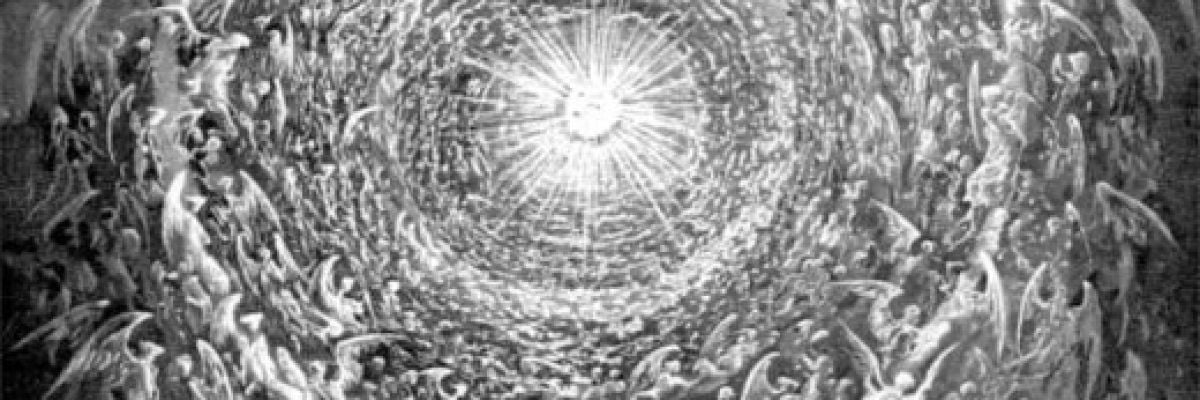
Dante’s Divine Comedy is a poem more known about than known. To the extent most Americans know about it at all, it’s in terms of Gustave Doré’s illustrations for the Inferno. Some will recognize snippets from the text, such as the inscription over the gate to hell: “Abandon all hope ye who enter here.”
Beyond that, the Divine Comedy is pretty much terra incognita for Americans. It’s a pity, because it’s one of the greatest works of literature ever fashioned, and, in my eyes, it’s the greatest epic poem ever written.
As impressive as the Iliad and the Aeneid are, I think Dante’s work outstrips them not only in terms of story but in terms of understanding the human condition. Homer and Virgil (whom Dante uses as his guide through hell and most of purgatory) wrote marvelously about the pagan or natural virtues, but only Dante, with the advantages of revelation, was able to write at a level both higher and deeper. Homer and Virgil wrote about heroes. Dante wrote about Everyman.
I confess it’s been many years—too many to justify—since I last turned to Dante. Now that I have somewhat more time on my hands, I thought it opportune to do a thorough-going study of his work. It came about as an adjunct to reading I’m doing about the history, art, and architecture of Florence, which, of course, was Dante’s city (away from which he died in exile).
I have two dozen books about Florence on my shelves at home, so I made a loose study plan, hoping to get through them by the end of the year, with an eye toward making my next visit to the city more fruitful. As I began that project, I realized that I ought to reconnect with Florence’s most famous son: thus the parallel study of The Divine Comedy.
My main text is the three-volume translation by Robert and Jean Hollander, partly because it has extensive notes but also because I’ve had their set on my shelves for years. I also have two or three other translations to which I’ll refer on occasion.
My goal is to study one canto per day. The poem consists of one hundred cantos in all, with the average canto being 143 lines. The poem is written in terza rima (triple rhyme), a form said to be invented by Dante. The first and third lines of each stanza rhyme, and the middle line rhymes with the first and third lines of the following stanza. That means the pattern is aba bcb cdc ded, and so on. The last stanza in each canto rhymes yzyz.
This rhyming pattern works well in Italian, which is rich in rhymable words. English is poor in them. Dorothy Sayers pulled off a terza rima translation, but by necessity it had to be largely a paraphrase. An English translation that will match Dante’s text closely will have to use some other format. Several English translations are in blank verse, which uses lines that have meter but no rhyme. This is what the Hollanders use.
As I said, my daily goal is to get through one canto, in both English and Italian. The Italian is, of course, medieval Italian (Tuscan, actually). Fortunately, Italian has changed more slowly than has English. Chaucer lived a long lifetime after Dante, but his Canterbury Tales are written in an English so archaic (Middle English) that most of us need a dictionary to get through it. Dante’s Italian is to modern Italian as Shakespeare’s English is to modern English: some odd words and spellings but otherwise accessible without the help of a lot of critical apparatus.
As I’ve been going through the early cantos, I’ve been noting how the Hollanders render the Italian, and they are fairly literalistic. Other translations I’ve consulted read more colloquially, but that doesn’t necessarily mean they’re easier to understand or sound better on the mental tongue. I like the care the Hollanders take in selecting the mot juste.
I’m reminded of something I once read about Joseph Conrad and Ford Madox Ford. The two of them used to discuss, until the wee hours, which words were best used to describe characters they were writing about. They once spent hours talking about whether Conrad should describe a man as “penniless” or “without a penny.” Of course, no reader would have noticed. No one would have said to himself, “Conrad calls this fellow ‘penniless,’ but ‘without a penny’ has a slightly different sense and would have been better.” But the distinction was important to Conrad and to Ford. Dante also was careful with his choice of words, and his translators need to be careful too. I think the Hollanders have been.
Along with their three volumes I am reading, in parallel, three other works: two commentaries and a bulky encyclopedia. The commentaries are Guy Raffa’s The Complete Danteworlds and Joseph Gallagher’s A Modern Reader’s Guide to Dante’s The Divine Comedy. They largely overlap but have different emphases. When I turn to a new canto, I read the corresponding sections of Raffa and Gallagher first, to get an overview.
Then I turn to the 1,000-page Dante Encyclopedia. I look up each person or idea mentioned in the commentaries. This can take a while, since in some cantos Dante names more than a dozen people whom he comes across in the afterlife. Only when I have done this reading do I turn to the text itself.
First I read through the English straight. Then I go back and read the Italian and English together, consulting Robert Hollander’s notes. The average canto takes ten pages in his book, five pages for the Italian and five facing pages for the English. The notes, set in smaller type, take six to ten pages. In word count, they are several times as long as the poem itself.
I’m finding that this daily routine is taking anywhere from one to two hours. If I can average one canto per day, I should finish in July.
On the side, I’m taking in related books. I recently finished the excellent Reading Dante: From Here to Eternity by Prue Shaw, and this week I’ll receive the just-published How Dante Can Save Your Life by Rod Dreher, which isn’t so much about the poem as about how the poem brought the author out of depression and closer to his estranged family. I’m also going through the Cambridge Companion to Dante. Books such as these I’m reading on a catch-as-catch-can basis.
I’ll have more to say about my Dante study and these (and other) books in future posts.



